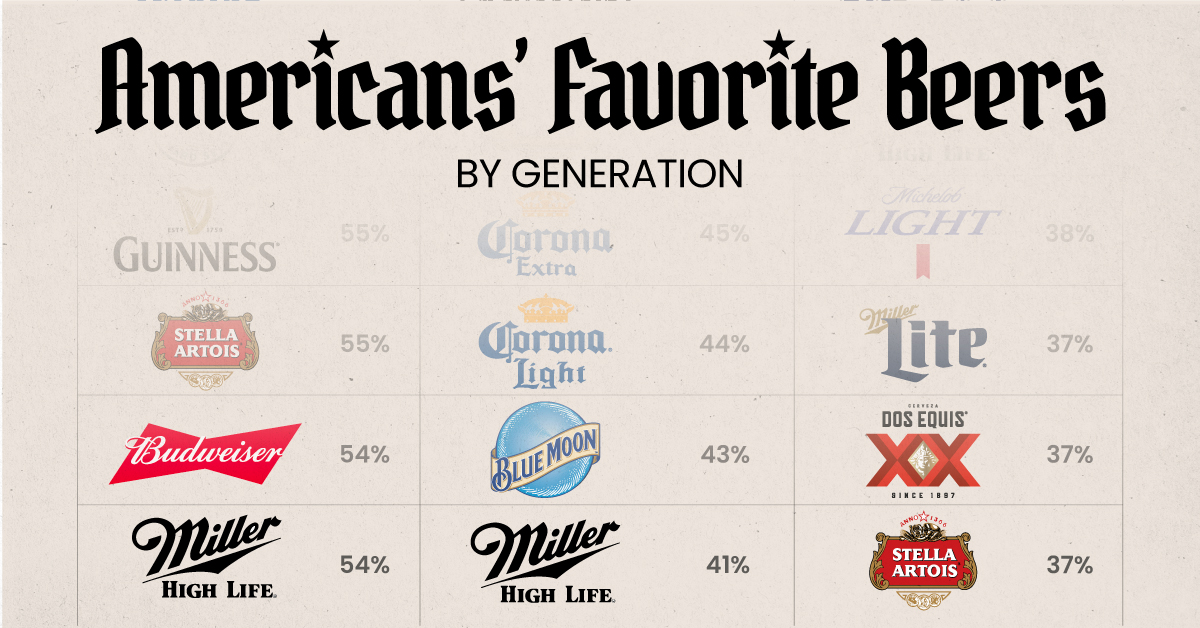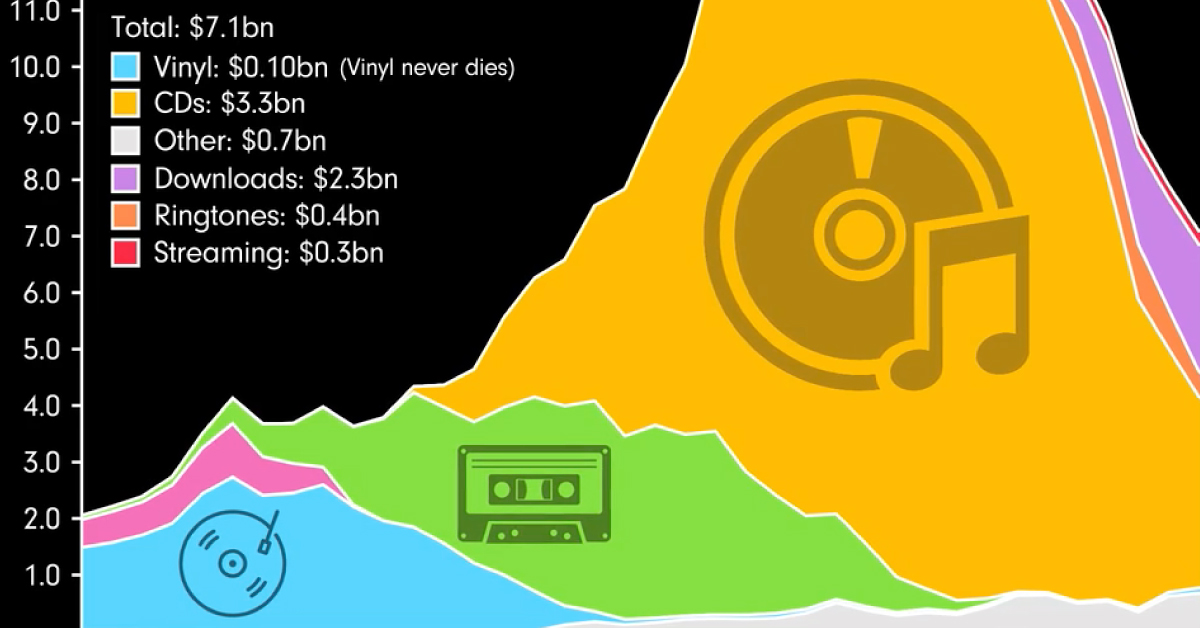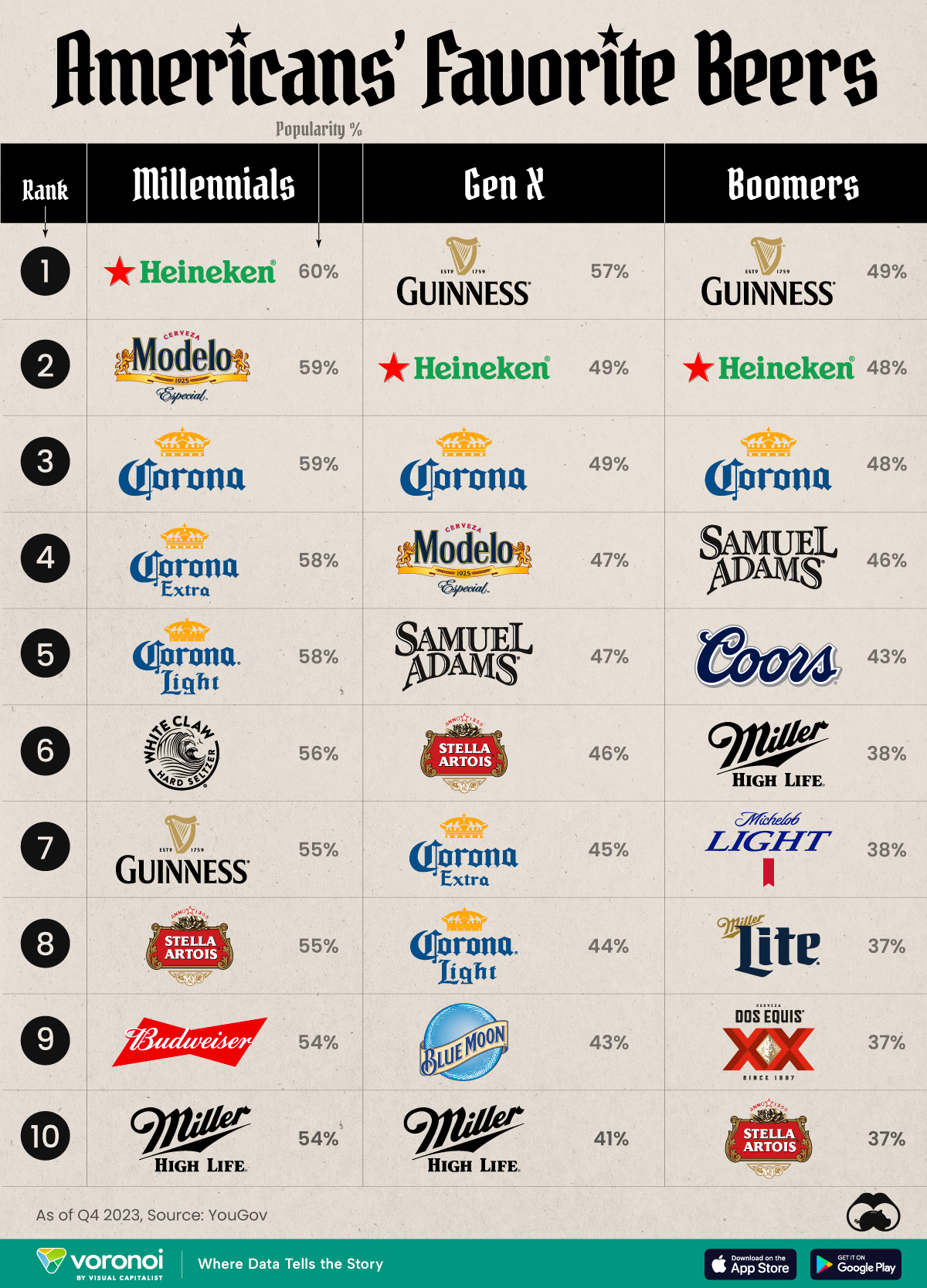Culture
Animated Chart: The Rise and Fall of Music Sales, by Format (1973-2021)
The Rise and Fall of Music Sales, by Format (1973-2021)
We live in a world of music. Whether when driving to work or jamming out at home, people around the world like to have their favorite tunes playing in the background.
But while our love for music has been constant, the way we consume media has evolved drastically. The past 50 years have seen many different music formats used to access these tunes, mirroring society’s shift from analog to digital.
This video, created by James Eagle using data from the Recording Industry Association of America (RIAA), highlights sales of different music formats in the U.S. over the last 50 years.
Vinyl
Up until the late 1980s, vinyl dominated the music format industry, earning billions of dollars in sales annually. Records of Bruce Springsteen’s Born to Run or Pink Floyd’s Dark Side of the Moon were some of the top selling albums available.
Vinyl is said to provide its listeners with analog sounds that reverberate and the warm notes of almost-live music. For vinyl users and enthusiasts to this day, the music produced by these sleek yet massive records is unparalleled.
8-Track
If you’re a millennial (or younger), you may have never heard of the 8-track. But this music format played an integral part in the history of music.
When the booming automotive vehicle industry found it challenging to translate the music experience to cars using vinyl, it looked to the “Stereo 8” eight-track cartridge, better known as the 8-track. This cartridge used an analog magnetic tape and provided 90 minutes of continuous music play time.
8-track carved a niche for itself much before the advent of cassettes and CDs. And through the proliferation of vehicles, 8-track sales climbed to reach a peak revenue of $900 million in 1978.
Cassettes
The era of cassettes pushed 8-tracks into the history of music in the early 1980s. These pocket-sized tapes were more convenient to use than 8Tracks and quickly spread worldwide.
By 1989, the cassette format reached its peak revenues of $3.7 billion.
CDs
First released in 1982, the Compact Disc or CD came into the music market as the successor to the vinyl record.
Developed by Philips and Sony, sales of the sleek and portable CD grew quickly as home and car stereos alike added CD functionality. The format brought in $13.3 billion in revenue in both 1999 and 2000. To date, no other music format has reached the same milestone since.
Digital Music Formats
When it comes to preferred music formats over time, convenience (and cost) seem to have been the biggest catalysts of change.
From the start of the early 2000s, CDs had started to be replaced by other forms of digital storage and distribution. The massive shift to internet consumption and the introduction of digital music, available through downloads, pushed audio CD sales down rapidly.
The launch of streaming platforms like Spotify in 2006 exacerbated this decline, with CD sales dropping by around $4 billion in five years.
Digital sales continued to evolve. Ringtone sales alone brought in $1.1 billion in 2007, and in 2012, the revenues from downloads shot up to a peak of $2.9 billion. But music streaming platforms kept climbing through 2021, and will likely continue to be the future face of music consumption.
| Rank | Music formats | Revenue in 2021 |
|---|---|---|
| 1 | Streaming | $11.5 billion |
| 2 | Vinyl | $1.0 billion |
| 3 | CD | $0.6 billion |
| 4 | Downloads | $0.5 billion |
| Other | $1.4 billion | |
| Total | $15.1 billion |
Music streaming and subscription services pushed the accessibility of music to new highs, especially with free ad-supported platforms.
In 2021, streaming secured the music industry a whopping $11.5 billion in sales, good for 76% of the total. If it keeps growing in popularity and accessibility, the format could potentially challenge the peak popularity of CDs in the late 90s.
The Vintage Comeback?
There’s no doubt that digital music formats are getting increasingly popular with every passing year. However, one of our vintage and beloved music formats—the vinyl record—seems to be making a comeback.
According to the RIAA database, the revenue earned by LP/EP sales has shot up to $1.0 billion in 2021, its highest total since the mid-1980s.

This article was published as a part of Visual Capitalist's Creator Program, which features data-driven visuals from some of our favorite Creators around the world.
Culture
Ranked: America’s Most Popular Beers, by Generation
We visualize the results of a YouGov survey that determined the most popular beers among each U.S. generation.

America’s Most Popular Beers, by Generation
This was originally posted on our Voronoi app. Download the app for free on iOS or Android and discover incredible data-driven charts from a variety of trusted sources.
In this graphic we’ve visualized the most popular beers for each U.S. generation as of Q4 2023, according to a consumer survey conducted by YouGov.
The “popularity” metric represents the % of people who had a positive opinion of that beer. Note that YouGov surveys are conducted with a representative sample of 1,500 respondents.
Overview: Millennials
U.S. millennials appear to favor foreign beers, with the top five spots taken by Dutch (Heineken) or Mexican beers (Modelo, Corona).
| Beer | Popularity (%) |
|---|---|
| 🇳🇱 Heineken | 60 |
| 🇲🇽 Modelo | 59 |
| 🇲🇽 Corona | 59 |
| 🇲🇽 Corona Extra | 58 |
| 🇲🇽 Corona Light | 58 |
| 🇺🇸 White Claw | 56 |
| 🇮🇪 Guinness | 55 |
| 🇧🇪 Stella Artois | 55 |
| 🇺🇸 Budweiser | 54 |
| 🇺🇸 Miller | 54 |
While not exactly a beer, White Claws (which have a similar alcohol content) claimed sixth place. Hard seltzers have become very popular in recent years due to their variety of flavors, attractive packaging, and relatively low amount of carbs and calories.
Overview: Gen X
Gen X also has a strong preference for foreign beers, particularly Guinness (fun fact: Over 31 million Americans claim to be of Irish descent).
| Beer | Popularity (%) |
|---|---|
| 🇮🇪 Guinness | 57 |
| 🇳🇱 Heineken | 49 |
| 🇲🇽 Corona | 49 |
| 🇲🇽 Modelo | 47 |
| 🇺🇸 Samuel Adams | 47 |
| 🇧🇪 Stella Artois | 46 |
| 🇲🇽 Corona Extra | 45 |
| 🇲🇽 Corona Light | 44 |
| 🇺🇸 Blue Moon | 43 |
| 🇺🇸 Miller | 41 |
Two American beers that weren’t on Millennials’ top 10 list are Samuel Adams and Blue Moon.
Samuel Adams is the flagship brand of the Boston Beer Company, named after U.S. Founding Father Samuel Adams. On the other hand, Blue Moon is a Belgian-style witbier brewed by Molson Coors.
Overview: Baby Boomers
Boomers’ top 10 favorite beers are similar to Gen X, with a few key differences. One is the absence of Modelo, which ranked second and fourth for Millennials and Gen X, respectively.
Modelo (which became America’s best-selling beer in 2023) has focused its advertising efforts on sports, which may not reach Boomers as effectively as younger generations.
| Beer | Popularity (%) |
|---|---|
| 🇮🇪 Guinness | 49 |
| 🇳🇱 Heineken | 48 |
| 🇲🇽 Corona | 48 |
| 🇺🇸 Samuel Adams | 46 |
| 🇺🇸 Coors | 43 |
| 🇺🇸 Miller | 38 |
| 🇺🇸 Michelob Light | 38 |
| 🇺🇸 Miller Lite | 37 |
| 🇲🇽 Dos Equis | 37 |
| 🇧🇪 Stella Artois | 37 |
An interesting pick for Boomers is Dos Equis, which is produced by Heineken-owned Cuauhtémoc Moctezuma Brewery. The brand gained popularity for its “most interesting man in the world” commercials, which ran from 2006 to 2018.
See More Beer Graphics 🍺
Be sure to check out this graphic which breaks down global beer consumption by country.
-

 Markets2 weeks ago
Markets2 weeks agoAmerica’s Top Companies by Revenue (1994 vs. 2023)
-

 Environment2 weeks ago
Environment2 weeks agoRanked: Top Countries by Total Forest Loss Since 2001
-

 Real Estate2 weeks ago
Real Estate2 weeks agoVisualizing America’s Shortage of Affordable Homes
-

 Maps2 weeks ago
Maps2 weeks agoMapped: Average Wages Across Europe
-

 Mining2 weeks ago
Mining2 weeks agoCharted: The Value Gap Between the Gold Price and Gold Miners
-

 Demographics2 weeks ago
Demographics2 weeks agoVisualizing the Size of the Global Senior Population
-

 Misc2 weeks ago
Misc2 weeks agoTesla Is Once Again the World’s Best-Selling EV Company
-

 Technology2 weeks ago
Technology2 weeks agoRanked: The Most Popular Smartphone Brands in the U.S.







